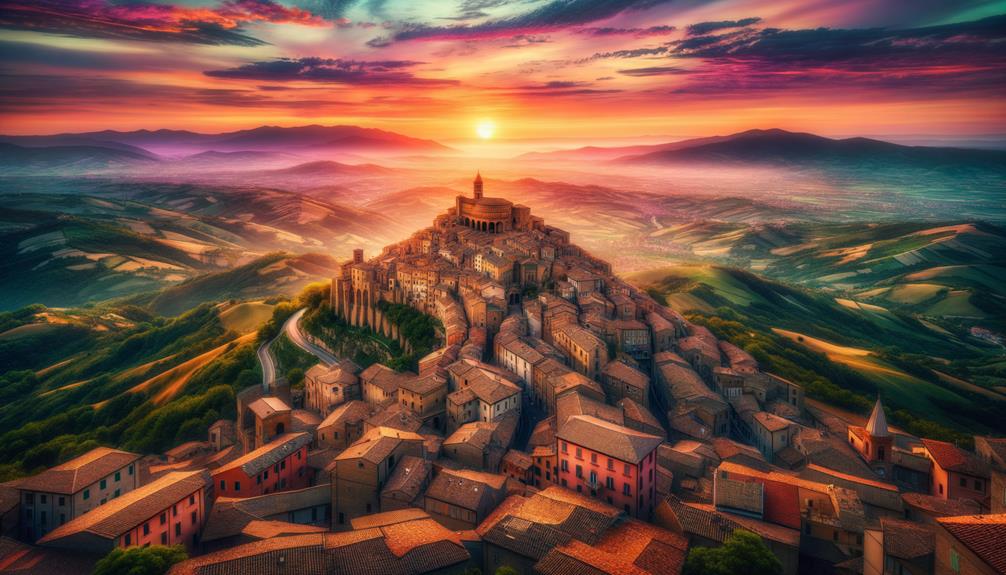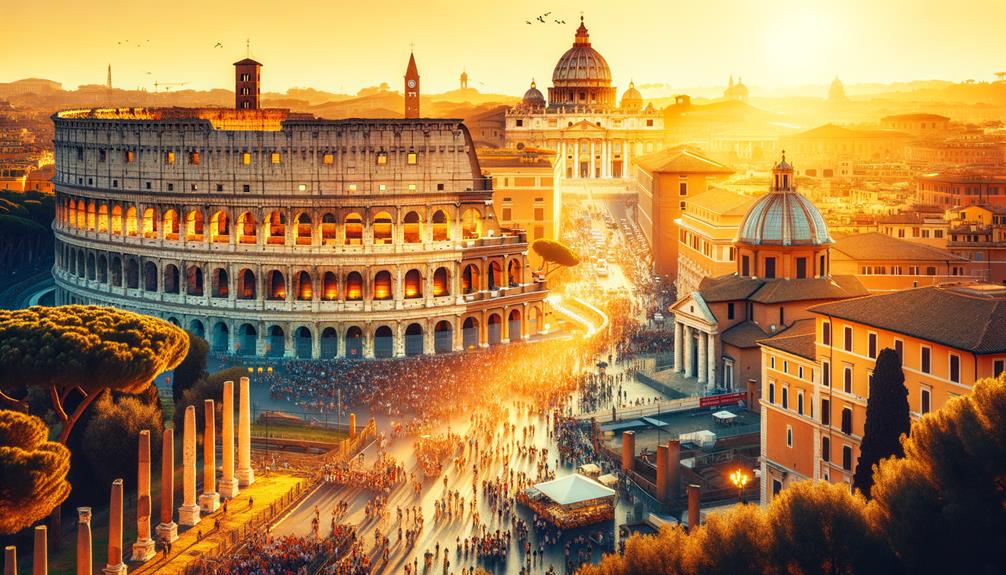Walking through Potenza, the center of the Basilicata region, I felt the blend of old and new come to life. The cobblestone streets seemed to tell stories from medieval times, especially near the towering Torre Guevara. The impressive architecture of Palazzo Loffredo and the peaceful ambiance of the Cathedral of San Gerardo left me in awe. Visiting the local markets was a treat for the senses, with the smell of freshly pressed olive oil and the taste of local wine. Every corner of Potenza has a story, just waiting to be found.
Potenza's Rich History
Located in the heart of the Basilicata region, Potenza's history is like a captivating storybook filled with ancient ruins, medieval castles, and vibrant cultural traditions. Walking through Potenza's historic center feels like stepping back in time. Each cobblestone street reveals tales of centuries past, from Roman conquests to medieval battles.
Strolling through the narrow alleys, I felt the rough texture of stone walls that have stood for centuries. The echoes of church bells from the Chiesa di San Michele Arcangelo added an ageless soundtrack to my exploration. As I wandered further, I came upon the Torre Guevara, a remnant of a once-mighty castle. Standing before it, I couldn't help but imagine the lives of knights and nobles who once roamed these grounds.
Cultural traditions are evident in every corner. I was fortunate to catch a local festival celebrating San Gerardo, Potenza's patron saint. The air buzzed with excitement as residents dressed in traditional costumes paraded through the streets, proudly showcasing their heritage. The historic center isn't just a place; it's a living testament to Potenza's enduring spirit.
Stunning Apennine Views
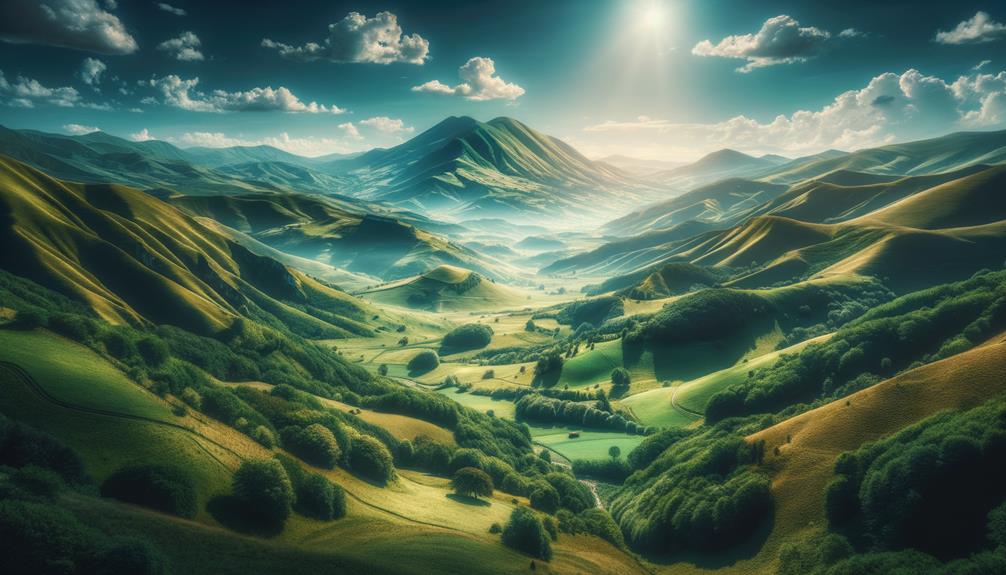
Standing atop one of Potenza's scenic overlook points, I found myself in awe of the endless mountain views stretching before me. The peaceful hiking trails winding through the Apennines offered more than just a physical journey; they felt like a spiritual experience. Each step unveiled new layers of natural beauty, as if the mountains were sharing ancient stories, inviting me to pause and soak in the region's calm splendor.
Panoramic Mountain Vistas
From the vantage point of Monte Vulture, the Apennine landscapes stretch out like a stunning tapestry of rolling hills, lush forests, and quaint villages that seem to have stood still in time. Standing on a high ridge, I felt like I was on top of the world, the air crisp and refreshing. The views seemed endless, a perfect blend of natural beauty and cultural heritage.
- The patchwork of vineyards and olive groves, a tribute to centuries-old farming traditions.
- The sparkling lakes nestled in volcanic craters, reflecting the sky's blue tones.
- The medieval castles perched on hilltops, telling stories of past eras.
One morning, I hiked up just to catch the sunrise. As the first light spilled over the mountains, the landscape below lit up with vibrant colors and shadows. It was a powerful reminder of nature's grandeur and our small place within it.
Locals often say that these views offer a glimpse into the soul of Basilicata. They're right. Each look from the high ridge reveals a new layer of the region's rich history, making it impossible not to feel a sense of freedom and connection.
Serene Hiking Trails
After soaking in the stunning views from Monte Vulture, I was eager to put on my hiking boots and wander through the peaceful trails of the Apennine Mountains. Each step brought new surprises and incredible scenery. My first stop was Gallipoli Cognato Park, where clearly marked paths led me through a rich mix of plants and animals. I was in awe of the colorful wildflowers and the occasional sighting of wildlife, feeling deeply connected to nature.
The trails cater to all skill levels, making them accessible to everyone. I began with an easy path and gradually tackled more challenging routes. Each trail had its own charm—ancient villages that seemed untouched by time, grand castles on hilltops, and historic sites that told stories of Basilicata's vibrant cultural heritage.
A highlight was finding a charming village tucked away in the mountains. The locals greeted me warmly, sharing stories of their ancestors and offering homemade treats. The combination of natural beauty and cultural richness made each hike an adventure. The Apennine Mountains, with their tranquil trails, are the perfect getaway for those seeking freedom and discovery.
Scenic Overlook Points
Nestled among the highest peaks, the scenic overlook points in the Apennine Mountains offer breathtaking vistas that capture the essence of Basilicata's untamed beauty. Standing at over a thousand meters above sea level, I felt the cool mountain breeze against my skin and marveled at the panoramic views that stretched endlessly before me.
- Jagged mountain peaks piercing the sky
- Verdant valleys carpeted with wildflowers
- Ancient villages nestled in the folds of the earth
Each overlook point tells a unique story. One particular spot, Monte Sirino, at 1,907 meters above sea level, provided a sweeping view of the surrounding landscape. I could see the shimmering lakes below and the serpentine roads weaving through the hills. The sight was so mesmerizing, it felt like time stood still.
Locals often gather at these points to share stories and legends, adding a cultural richness to the natural splendor. I met an elderly shepherd who recounted tales of the region's history, his eyes gleaming with pride. These encounters made me realize that Basilicata is not just about the sights but also the people who call this rugged land home.
—
Perched among the Apennine Mountains' highest peaks, the scenic overlook points showcase Basilicata's raw beauty. Over a thousand meters up, the cool mountain breeze and endless panoramic views were simply awe-inspiring.
- Jagged peaks slicing the sky
- Valleys bursting with wildflowers
- Ancient villages tucked into the landscape
Each overlook has its own story. For example, Monte Sirino, standing at 1,907 meters, offered a breathtaking view of lakes below and winding roads through the hills. The sight was so captivating; it felt as if time had paused.
Locals often gather at these spots to share stories and legends, adding a rich cultural layer to the experience. I met an elderly shepherd who shared tales of the region's history with pride. These moments made me appreciate that Basilicata is about more than just the scenery—it's about the people who make this rugged land their home.
Modern and Ancient Architecture

Walking through the streets of Potenza, I was amazed by how well the Roman-style buildings blend with medieval fortresses. The mix of old stone walls and modern urban design tells a story of resilience and adaptation. One of my favorite spots is the Ponte San Vito, where the medieval architecture perfectly frames the modern city.
Roman-Influenced Structures
Walking through Potenza, you can't help but admire how the city's Roman-influenced architecture blends the old with the new. Strolling across the Ponte San Vito, a medieval bridge, you feel a connection to Potenza's rich history. The bridge offers sweeping views of the city, where Roman design principles still stand out among its landmarks.
Here are some highlights that left a lasting impression on me:
- Cathedral of San Gerardo: Renovated in the 18th century, this cathedral is a testament to enduring faith and brilliant architecture.
- Palazzo Loffredo: This 17th-century palace, now a museum, combines modern exhibitions with its classical Roman-inspired design.
- Chiesa di San Michele Arcangelo: Featuring live organ music and classic religious art, this church showcases the region's spiritual and artistic traditions.
Potenza's Roman-influenced structures are more than just buildings; they tell stories. The church of San Francesco, founded in 1274, houses a Byzantine Madonna and the De Grasis sepulcher, pulling you deeper into its history. For anyone eager to uncover the past and enjoy a sense of discovery, Potenza's architectural gems offer a unique journey through time.
Medieval Castles and Fortresses
Walking through Potenza, you can't help but notice the remnants of its medieval past. The remains of its castles and fortresses may be few, but they speak volumes about the city's rich history. The medieval castle here is mostly gone, leaving only the Torre Guevara. Standing near this lone tower, you get a real sense of the area's historical and cultural weight. The stones seem to tell stories of old battles and bygone days.
A visit to the Palazzo Loffredo, now a museum, takes you even deeper into Potenza's medieval era. The artifacts on display offer a vivid glimpse into life back then. Then there's the Ponte San Vito, a medieval bridge that not only offers scenic views but also showcases the engineering skills of the Middle Ages. As you walk across it, you can almost picture the merchants and knights who once trod these paths.
Don't miss the Chiesa di San Francesco, a church with stunning 13th-century architecture. Every visit to this historical building deepens your appreciation for Potenza's medieval heritage, sparking a longing for the adventure of those ancient times.
Contemporary Urban Designs
As I wander through Potenza, I'm amazed at how well modern and ancient architecture coexist. Walking along Via Pretoria, a pedestrian-only street, the city's vibrancy is palpable. The street's charm comes from its unique mix of:
- Historic landmarks like the Cathedral of San Gerardo, notable for its Romanesque rose window.
- The 17th-century Palazzo Loffredo, now a museum that highlights Potenza's cultural heritage.
- The iconic Ponte San Vito, offering scenic views and showcasing medieval engineering.
Strolling down Via Pretoria, I'm struck by how the modern shops and cafés blend effortlessly with centuries-old structures. The Chiesa di San Francesco stands out as a testament to the city's medieval past, its stunning architecture drawing in visitors.
As I sip my espresso at a contemporary café, I reflect on how Potenza's urban design fosters a sense of freedom and discovery. It's a city that honors its past while welcoming the future, offering a perfect balance for those who appreciate both history and modernity.
Cultural Attractions
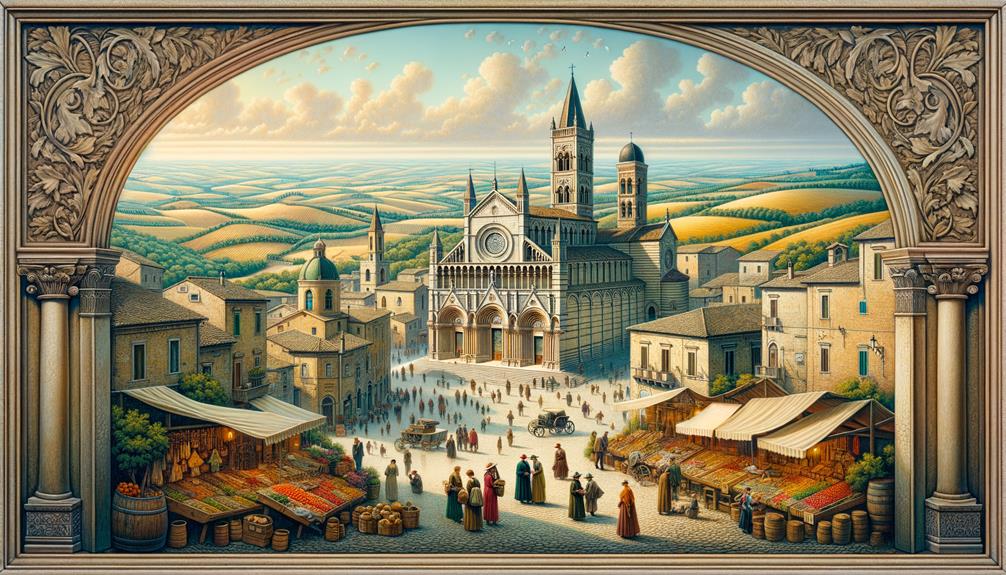
The cathedral of San Gerardo, with its 18th-century renovations, offers a peek into Potenza's rich history and stands as a testament to the city's enduring cultural legacy. As I wandered through its ancient aisles, I could almost hear the whispers of the past echoing in the ornate walls.
But Potenza's charm doesn't end there. The Palazzo Loffredo, a stunning 17th-century palace, now serves as a museum. Walking through its halls, I marveled at the ancient Greek and Roman pottery, jewelry, and religious objects on display. It's like stepping back in time, each artifact telling its own unique story.
Here's a quick snapshot of some must-visit cultural spots:
| Attraction | Highlights |
|---|---|
| Palazzo Loffredo | Ancient artifacts, museum atmosphere |
| Chiesa di San Francesco | De Grasis sepulcher, Byzantine Madonna |
| Chiesa di San Michele de Arcangelo | Live organ music, classic religious art |
In the heart of the city, the historic center is full of life. The Torre Guevara and the Palazzo Goffredo showcase the region's rich cultural heritage. Every corner of Potenza invites you to explore, offering a blend of history, art, and an unmistakable sense of freedom.
Potenza Cathedral
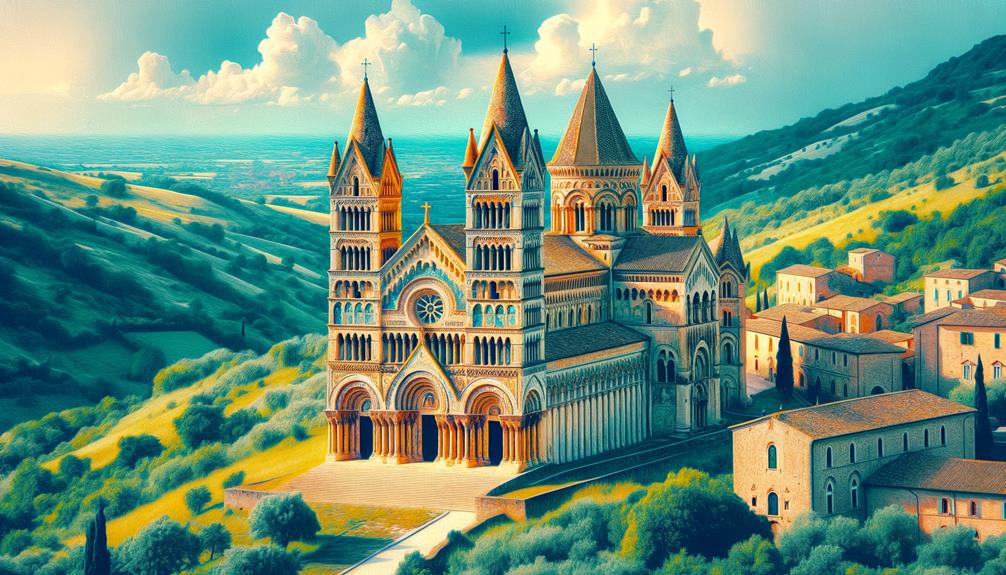
When I walked into the square, the rough grey stone of Potenza Cathedral immediately caught my eye. Dating back to the 12th century, its 18th-century renovations have only added to its appeal, making it a cherished landmark in the city. With its rich history and dedication to San Gerardo, the patron saint of Potenza, it's a place where the past comes alive.
Historical Significance Overview
Standing in front of Potenza Cathedral, the weight of centuries etched into its rough grey stones is unmistakable. Also known as the Cathedral of San Gerardo, this stunning structure was built in the 12th century and has seen the passage of time.
As I stood there, the vibrant activity around the cathedral was hard to miss. It's located in a charming square where young people gather, bringing a lively energy to this historic site. The surrounding pretty houses, including remnants of a former convent, add to the historic charm, creating a picturesque setting.
- The weathered stones of the cathedral have silently witnessed centuries of history.
- The square buzzes with life, mixing the old with the new.
- The surrounding buildings hint at stories of monastic life from centuries past.
Walking through Potenza, the Cathedral of San Gerardo stands out as a powerful reminder of the city's rich cultural heritage. It's not just a religious site; it's a symbol of endurance and a testament to the many layers of history that define this place. The cathedral's historical significance makes it a must-see landmark.
Architectural Highlights
In the heart of Potenza's historic center, the Potenza Cathedral catches your eye with its Romanesque rose window, a beautiful reminder of its medieval past. As I walked towards the Cathedral of San Gerardo, this intricate detail stood out to me, blending seamlessly with the 18th-century renovations that shape its current look.
Inside, the mix of history and restoration is palpable. The nave, with its graceful lines and arches, tells stories of the many hands that have built, cared for, and restored this sacred space over the years. The 1980 Irpinia earthquake left its mark, but the cathedral's resilience mirrors the spirit of Potenza itself. Each carved stone and fresco seems to whisper tales of devotion and community.
One detail that caught my attention was the peaceful statue of San Gerardo, Potenza's patron saint. It represents the city's enduring faith and cultural identity. The cathedral isn't just an architectural gem; it's a living reflection of Potenza's history and the spirit of its people. Visiting the Cathedral of San Gerardo isn't just a visual experience; it's a journey for the soul.
Museums to Explore
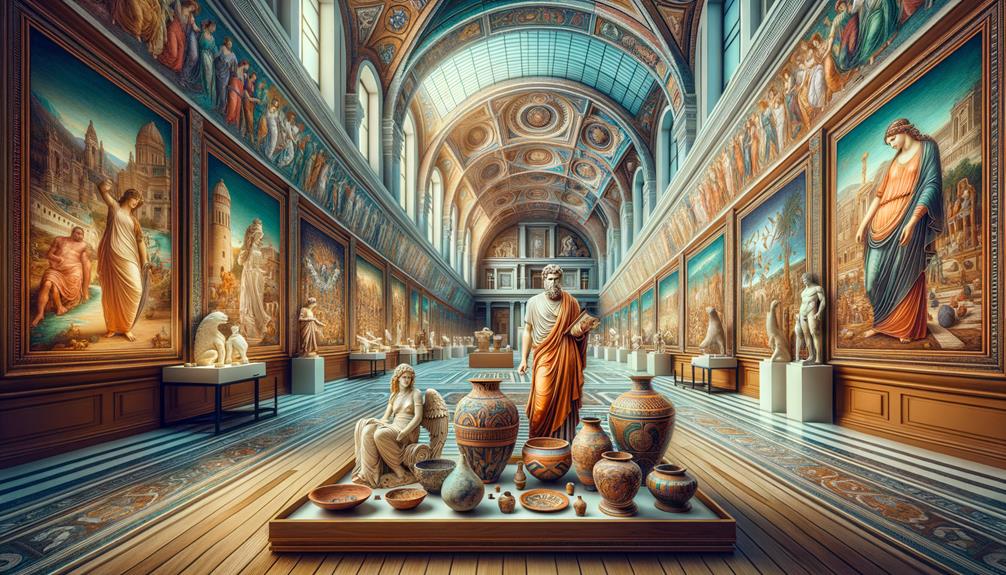
Discovering the museums in Potenza offers a captivating look at the rich history and vibrant culture of the Basilicata region. My first stop was the National Archaeological Museum, filled with ancient artifacts that tell the story of Potenza's past. Walking through the exhibits, I felt a deep connection to the ancient civilizations that once thrived here. The intricate pottery and delicate jewelry unearthed from archaeological digs were truly mesmerizing.
- Ancient Artifacts: Admire the well-preserved relics from the prehistoric era.
- Roman History: See the influence of Roman civilization through statues and mosaics.
- Local Culture: Learn about the unique traditions and heritage of the Basilicata region.
Another highlight is the Diocesan Museum, located in a historic palace. The religious artifacts, including ornate vestments and sacred art, reveal the deep spiritual roots of the region. The Provincial Archaeological Museum offers a more localized perspective, showcasing items that highlight the daily lives of ancient inhabitants.
Each museum visit felt like peeling back the layers of time, offering a sense of freedom to explore and understand the cultural tapestry that makes Potenza so enchanting.
Economic Contributions
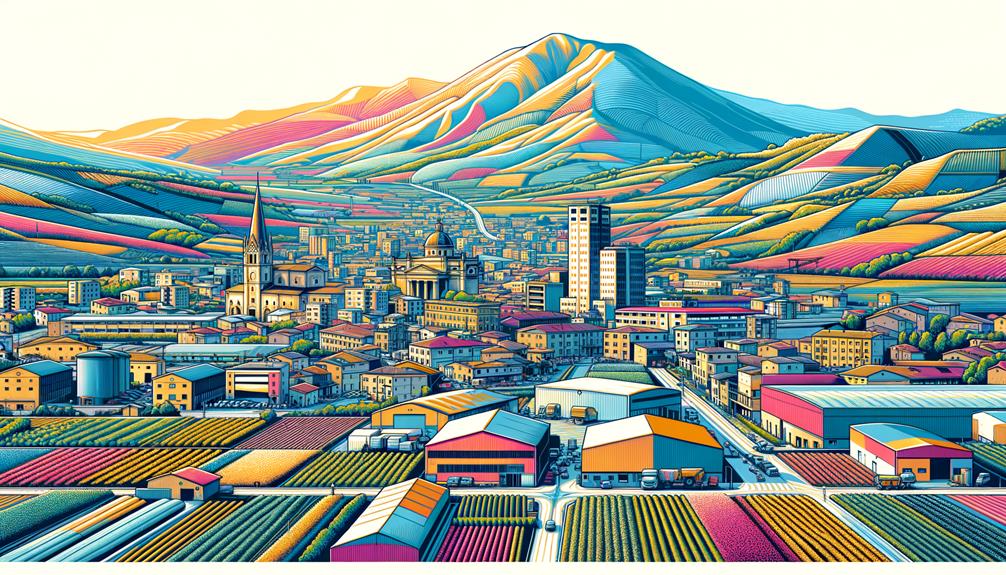
After soaking in Potenza's rich cultural heritage through its museums, I couldn't help but notice how the city's lively economic activities complement its historical significance. As the capital of Basilicata, Potenza stands as a key economic center, its prosperity deeply tied to its strategic location in the Apennines. Walking through the bustling streets, I saw firsthand how the city's industries thrive, benefiting from their access to natural resources and enabling trade with other regions.
One of my favorite finds was Potenza's role as a railway junction on the Salerno-Taranto line. This spot not only boosts the movement of goods and people but also highlights the city's role in linking Basilicata with wider markets. The constant activity of the railway is a clear reminder of Potenza's dynamic economic scene.
Local administration here plays a vital role, creating policies that encourage economic growth and draw in investment. This proactive governance is visible in the city's well-kept infrastructure and bustling business sectors. Potenza's economic vitality is a testament to its ability to blend modern industry with its rich cultural backdrop, making it a fascinating place to explore.
Agricultural Significance

Potenza's rich agricultural landscape is on full display at its bustling markets, brimming with fresh produce thanks to the region's fertile soil and ideal Mediterranean climate. As you wander through, the vibrant colors and enticing aromas are a feast for the senses. The fields and orchards of Basilicata not only nourish the local community but also support exports around the globe.
- Expansive olive groves: These groves produce some of Italy's top-tier olive oil.
- Vineyards: Scattered across the landscape, these vineyards are the backbone of Basilicata's renowned wine industry.
- Orchards: Overflowing with a variety of fruits and nuts, they highlight the region's diverse agricultural offerings.
These markets are a sensory delight, with vendors enthusiastically offering samples of their fresh fruits, vegetables, and nuts. I often find myself drawn to the olive oil stands, where the rich, golden oil is a staple of the local cuisine. The region's agricultural success doesn't stop at produce; it extends to exceptional wine production. The vineyards here, rooted in centuries-old traditions, produce wines that are appreciated far and wide. In Basilicata, agriculture is more than just an industry; it's a way of life, deeply woven into the cultural fabric of the region.
Picturesque Landscapes
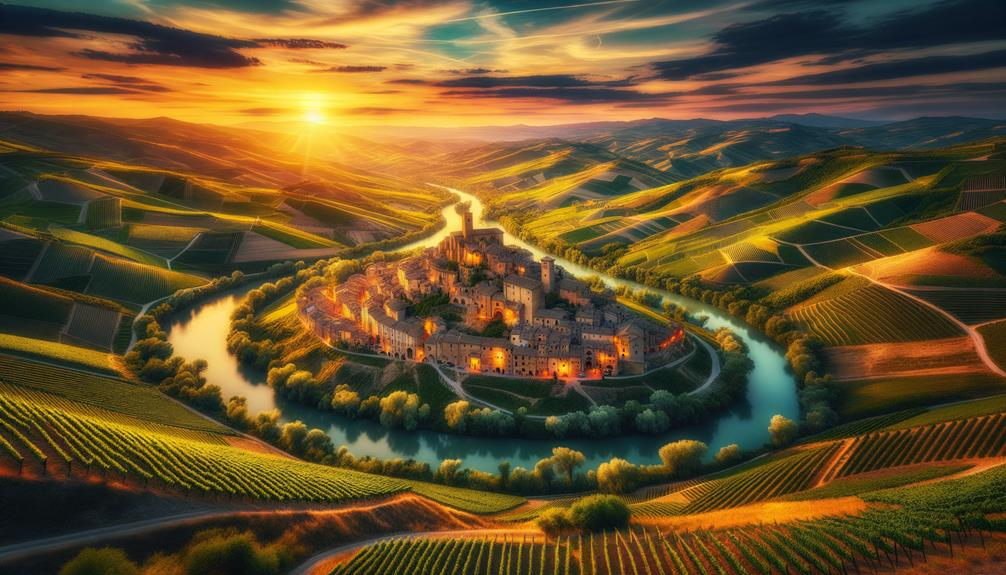
Walking through the rolling hills and ancient villages of Basilicata, I found myself constantly amazed by the stunning views at every corner. The landscapes here are truly a sight to behold, with fields of sunflowers dancing in the breeze and vineyards stretching endlessly. It feels like stepping into a painting where nature and history blend seamlessly.
One of the highlights was discovering a hidden valley that seemed frozen in time. The air was sweet with the scent of wildflowers, and the faint sound of a shepherd's flute added a magical touch. The rugged mountains, often shrouded in mist, created an atmosphere that felt incredibly freeing.
The locals speak passionately about their connection to the land, and it's easy to see why. Each hill and valley has a story to tell, and every ancient stone seems to whisper secrets from the past. Basilicata's landscapes invite you to wander, to immerse yourself in their beauty, and to find a sense of peace that's indescribable yet unforgettable.
Must-Visit Destinations
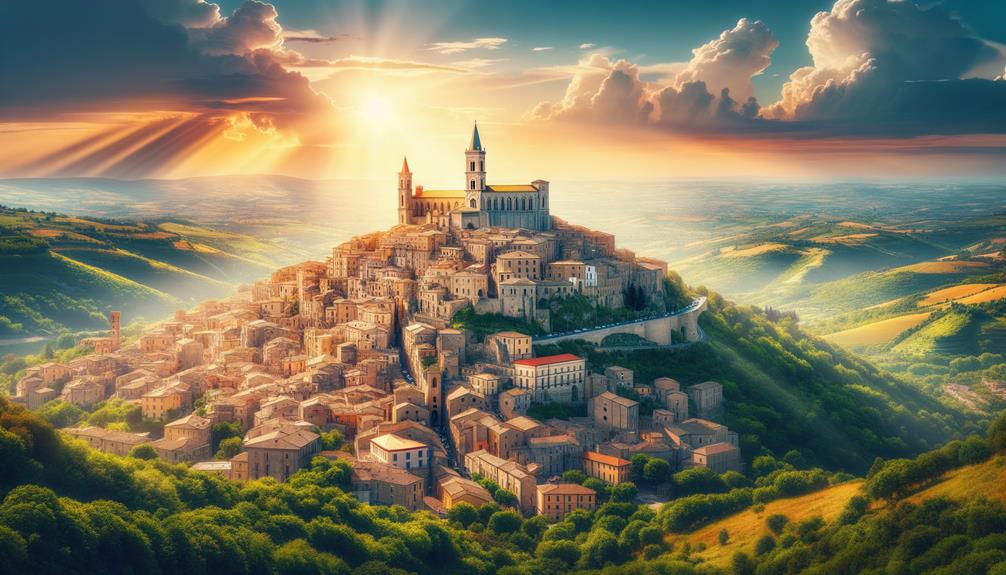
As I wandered through Basilicata's beautiful landscapes, Potenza's historic spots drew me in, each with its own unique charm. My adventure kicked off at the Cathedral of San Gerardo. This 18th-century gem, dedicated to Potenza's patron saint, San Gerardo, amazed me with its detailed frescoes and peaceful ambiance. Walking through its halls, I felt deeply connected to the city's rich history.
Next, I headed to the Church of San Francesco. Established in 1274, this Gothic wonder features the impressive De Grasis sepulcher and a stunning 13th-century Byzantine-style Madonna. The artistry and spirituality were truly captivating.
To get a real sense of Potenza's past, I visited Palazzo Loffredo. This 17th-century palace, now a museum, offered fascinating insights into the region's cultural heritage.
- The medieval Ponte San Vito: Stroll across this bridge for stunning views of Potenza.
- Chiesa di San Michele de Arcangelo: Enjoy live organ music and classic religious art.
- Palazzo Loffredo: Immerse yourself in history at this palace-turned-museum.
Potenza's charm lies in these timeless spots, each telling a piece of its storied past.
Frequently Asked Questions
What Is the Basilicata Region Well Known For?
The Basilicata region's stunning landscapes, delicious local dishes, rich history, and outdoor activities are always a draw for me. I enjoy visiting places like Potenza, tasting lagana, and experiencing lively street art festivals.
What Is Potenza Italy Famous For?
Potenza, Italy is rich in history and culture. I was amazed by its Byzantine-style art, enjoyed the lively Piazza Mario Pagano, and delighted in traditional dishes like lagana. The city's charm feels like a hidden gem.
Is Potenza, Italy Worth Visiting?
Absolutely, Potenza is worth a visit! I strolled through its historic center, admired the stunning 12th-century cathedral, and savored local dishes like lagana. The evening atmosphere, with bustling streets and lively festivals, truly won me over.
Is Potenza Worth Seeing?
Potenza is a hidden gem. Walking its cobblestone streets feels like stepping back in time. The hilly paths offer a sense of journey through history, and the local festivals bring a lively, authentic atmosphere that's hard to resist.

